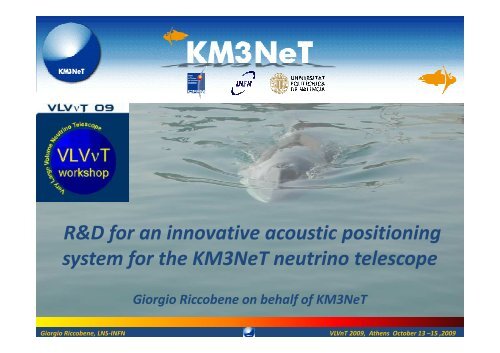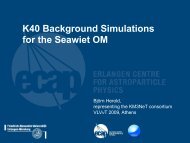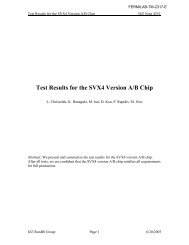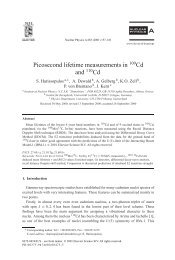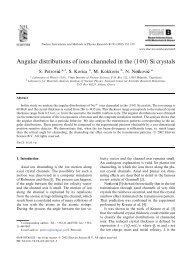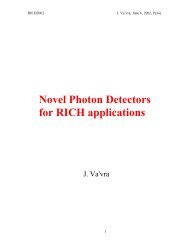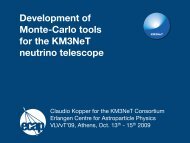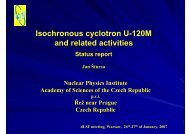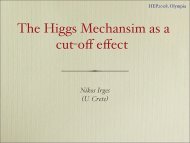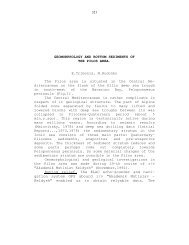R&D for an innovative acoustic positioning system for the KM3NeT ...
R&D for an innovative acoustic positioning system for the KM3NeT ...
R&D for an innovative acoustic positioning system for the KM3NeT ...
You also want an ePaper? Increase the reach of your titles
YUMPU automatically turns print PDFs into web optimized ePapers that Google loves.
R&D <strong>for</strong> <strong>an</strong> <strong>innovative</strong> <strong>acoustic</strong> <strong>positioning</strong><br />
<strong>system</strong> <strong>for</strong> <strong>the</strong> <strong>KM3NeT</strong> neutrino telescope<br />
Giorgio Riccobene on behalf of <strong>KM3NeT</strong><br />
Giorgio Riccobene, LNS-INFN VLVnT 2009, A<strong>the</strong>ns October 13 –15 ,2009
The deep sea <strong>acoustic</strong> <strong>positioning</strong> <strong>system</strong><br />
The <strong>acoustic</strong> <strong>positioning</strong> is a m<strong>an</strong>datory sub<strong>system</strong> <strong>for</strong> <strong>the</strong> detector<br />
Requirements:<br />
• relative <strong>positioning</strong> accuracy:
Key elements of <strong>the</strong> deep sea <strong>acoustic</strong> <strong>positioning</strong> <strong>system</strong><br />
Key elements <strong>for</strong> <strong>the</strong> Acoustic Positioning System (APS)<br />
- Auto-calibrating Long Baseline of <strong>acoustic</strong> tr<strong>an</strong>sceivers <strong>an</strong>chored in known<br />
<strong>an</strong>d fixed positions.<br />
- Array of <strong>acoustic</strong> sensors (hydrophones) moving with <strong>the</strong> Detection Unit<br />
mech<strong>an</strong>ical structure<br />
- Data acquisition <strong>an</strong>d tr<strong>an</strong>smission <strong>system</strong><br />
- Data <strong>an</strong>alysis <strong>system</strong><br />
Detection<br />
Unit<br />
Measurement Technique:<br />
1) TDoA (Time Difference of Arrival)<br />
T Emit (Beacon) – T Receive (Hydro)<br />
Hydrophone<br />
2) Geometrical Tri<strong>an</strong>gulation<br />
LBL<br />
tr<strong>an</strong>sceivers<br />
Giorgio Riccobene, LNS-INFN VLVnT 2009, A<strong>the</strong>ns October 13 –15 ,2009
Requirements <strong>for</strong> TDOA measurements<br />
- Common (<strong>an</strong>d absolute) timing <strong>for</strong> beacons <strong>an</strong>d hydrophones:<br />
phased <strong>an</strong>d shyncronised apparatus with
The NEMO Phase 1 experience<br />
In NEMO Phase 1 <strong>an</strong> <strong>acoustic</strong> <strong>positioning</strong> <strong>system</strong> based on commercial technology was<br />
used. We used <strong>an</strong> “<strong>acoustic</strong> poisitionig board” with DSP onboard connected to <strong>the</strong> FCM:<br />
<strong>acoustic</strong> signal <strong>an</strong>alysis underwater beacon signal detection time sent to shore to<br />
recover hydrophone position.<br />
GPS Time packet (1 Hz)<br />
15 m<br />
300 m<br />
Acoustic<br />
<strong>positioning</strong> board<br />
200 kHz digitization<br />
Detection time of<br />
Beacon Signal<br />
Independent<br />
Beacon<br />
Acoustic<br />
<strong>positioning</strong> PCs<br />
Giorgio Riccobene, LNS-INFN VLVnT 2009, A<strong>the</strong>ns October 13 –15 ,2009
The NEMO Phase 1 experience<br />
Calculation of dist<strong>an</strong>ce beetween <strong>the</strong> two hydrophones installed on a Floor<br />
Measured dist<strong>an</strong>ce in laboratory = 14.25 m<br />
Me<strong>an</strong> value from <strong>acoustic</strong> data = 14.24 m<br />
Giorgio Riccobene, LNS-INFN VLVnT 2009, A<strong>the</strong>ns October 13 –15 ,2009
The NEMO- OνDE experience: Oce<strong>an</strong> Noise Detection Experiment<br />
4 hydrophones (10 Hz-40 kHz b<strong>an</strong>dwidth) synchronized.<br />
Acoustic signal digitization (24bit@96 kHz) at 2000m depth.<br />
Data tr<strong>an</strong>smission on optical fibers over 28 km.<br />
On-line monitoring <strong>an</strong>d data recording on shore. Recording 5’ every hour.<br />
Data taking from J<strong>an</strong>. 2005 to Nov. 2006 (NEMO Phase 1 deployed).<br />
hydrophones<br />
electronics<br />
housing<br />
Average noise 2005-2006<br />
Sea State 2<br />
Sea State 0<br />
Giorgio Riccobene, LNS-INFN VLVnT 2009, A<strong>the</strong>ns October 13 –15 ,2009
The NEMO- OνDE experience: Oce<strong>an</strong> Noise Detection Experiment<br />
Sperm whale<br />
clicks<br />
Depth = 560 ± 5 m<br />
L = 3.41 ± 0.05 m<br />
Size = 9.72 - 10.50 m<br />
Young male or female<br />
OνDE sensitivity allowed cetace<strong>an</strong>s detection over >10 km r<strong>an</strong>ge.<br />
The results indicate presence of sperm whales more frequent th<strong>an</strong> previously<br />
observed.<br />
1 <strong>an</strong>imal<br />
Long term observation <strong>an</strong>d source<br />
2 <strong>an</strong>imals<br />
3 <strong>an</strong>imals<br />
tracking is used to determine marine<br />
>3 <strong>an</strong>imals<br />
mammals presence <strong>an</strong>d seasonal<br />
routes.<br />
INFN <strong>an</strong>d<br />
CIBRA<br />
Science, March 2, 2007<br />
Giorgio Riccobene, LNS-INFN VLVnT 2009, A<strong>the</strong>ns October 13 –15 ,2009
The ANTARES experience<br />
Acoustic Positioning System based on commercial technology (Genisea/ECA).<br />
LBL tr<strong>an</strong>sceivers on <strong>the</strong> BSSs <strong>an</strong>d receivers on <strong>the</strong> line.<br />
Line reconstruction: <strong>acoustic</strong> data + environmental sensors + compasses+ mech<strong>an</strong>ical model<br />
Tr<strong>an</strong>sceiver<br />
Receivers<br />
Floor 1<br />
Floor 8<br />
Floor 14<br />
Floor 20<br />
Floor 25<br />
BSS<br />
ANTARES Line<br />
Tr<strong>an</strong>sceivers<br />
Giorgio Riccobene, LNS-INFN VLVnT 2009, A<strong>the</strong>ns October 13 –15 ,2009
The ANTARES experience<br />
Absolute positions of LBL tr<strong>an</strong>ceivers:<br />
• Determined from surface (ship GPS)<br />
• Accuracy improved via LBL tri<strong>an</strong>gulation<br />
(tens cm)<br />
Detector <strong>an</strong>gular uncertainty<br />
σ (horizontal) = 0.13°<br />
σ (vertical) = 0.06°<br />
Giorgio Riccobene, LNS-INFN VLVnT 2009, A<strong>the</strong>ns October 13 –15 ,2009
R&D <strong>for</strong> <strong>an</strong> integrated Acosutic Positioning System<br />
Major innovations compared to <strong>the</strong> ANTARES <strong>an</strong>d NEMO Phase 1 experience<br />
• Fully time phased <strong>an</strong>d synchronised array of tr<strong>an</strong>smitters <strong>an</strong>d receivers<br />
• “All data to shore” philosophy<br />
Hydrophone data is rate fully sustainable<br />
Better/faster data <strong>an</strong>alysis tools on shore<br />
Large room <strong>for</strong> associated science et al.<br />
• Use of audio professional electronics components / data tr<strong>an</strong>smission protocols<br />
Reduce costs<br />
Improve reliability<br />
Integrate APS in <strong>the</strong> detector DAQ <strong>an</strong>d data tr<strong>an</strong>smission electronics<br />
Improve data exch<strong>an</strong>ge with associated science<br />
• Auto-calibrating <strong>an</strong>d multi-frequency LBL integrated with <strong>the</strong> DAQ chain<br />
Giorgio Riccobene, LNS-INFN VLVnT 2009, A<strong>the</strong>ns October 13 –15 ,2009
Proposed Acoustic Positioning System <strong>for</strong> <strong>the</strong> <strong>KM3NeT</strong><br />
Acoustic Positioning <strong>system</strong> :<br />
Minimal autocalibrating LBL (autonomous or cabled)<br />
Definitive autocalibrating LBL (connected to KM3 shore clock)<br />
tr<strong>an</strong>sceivers on junction boxes<br />
hydrophones on <strong>the</strong> tower floors<br />
PJB with LBL tr<strong>an</strong>sceiver<br />
Autonomous LBL<br />
SJB with LBL tr<strong>an</strong>sceiver<br />
Detection Unit<br />
MEOC<br />
Cable PJB-SJB<br />
Cable SJB-Tower<br />
Giorgio Riccobene, LNS-INFN VLVnT 2009, A<strong>the</strong>ns October 13 –15 ,2009
The hydrophone data acquition chain<br />
“All data to shore” philosophy payload: 2 Hydros = 12Mb/s, fully sustainable<br />
Hydros +<br />
preamps<br />
Acoustic Data Server<br />
ADS<br />
ADC<br />
Storey Control Module<br />
Adds GPS Time<br />
Sends Acou-data to shore<br />
TCP/IP<br />
Associated science<br />
OMs<br />
optical<br />
fiber link<br />
On-Shore<br />
Storey Conrtol Module<br />
Data Parsing<br />
Acoustic<br />
Positioning<br />
Storey scheme scheme<br />
Hydrophone frequency r<strong>an</strong>ge:<br />
Hydrophone (+ preamp) sensitivity<br />
ADC dynamic r<strong>an</strong>ge<br />
ADC sampling frequency<br />
1 kHz < f < 70 kHz<br />
∼ -170 dB re V/µPa<br />
∼ 120 dB (24 bits / 18÷20 bits effective)<br />
192 kHz (96 kHz optional)<br />
GPS time added offshore by <strong>the</strong> Storey Control Module<br />
Acoustic data tr<strong>an</strong>smission rate 32 bits @ 192 kHz 6.2 Mb/s (1 hydro)<br />
Giorgio Riccobene, LNS-INFN VLVnT 2009, A<strong>the</strong>ns October 13 –15 ,2009
The hydrophone data acquition chain<br />
“All data to shore” philosophy payload: 2 Hydros = 12Mb/s, fully sustainable<br />
Hydros +<br />
preamps<br />
Acoustic Data Server<br />
ADS<br />
ADC<br />
Storey Control Module<br />
Adds GPS Time<br />
Sends Acou-data to shore<br />
TCP/IP<br />
Associated science<br />
OMs<br />
optical<br />
fiber link<br />
On-Shore<br />
Storey Control Module<br />
Data Parsing<br />
Acoustic<br />
Positioning<br />
Storey scheme scheme<br />
Full data <strong>an</strong>alysis on shore with dedicated hardware <strong>an</strong>d/or software<br />
Data acquisition onshore:<br />
• The Storey Control Module onshore parses <strong>the</strong> Acoustic data from <strong>the</strong> data Stream<br />
• Acoustic Data are reconstructed <strong>an</strong>d distributed to clients by <strong>the</strong> ADS using<br />
professional Audio Borads (<strong>for</strong> tests) or custom FPGA-based boards.<br />
Giorgio Riccobene, LNS-INFN VLVnT 2009, A<strong>the</strong>ns October 13 –15 ,2009
R&D: Hydrophones <strong>an</strong>d Preamps<br />
Commercial hydrophones are typically factory calibrated:<br />
piston test at 250 Hz, water pool test above 5 kHz (due to reflections)<br />
directionality pattern<br />
But <strong>for</strong> m<strong>an</strong>y hydrophones sensitivity ch<strong>an</strong>ges as a function of pressure (∼ -3 dB/1000 m)<br />
INFN <strong>an</strong>d <strong>an</strong> itali<strong>an</strong> comp<strong>an</strong>y (SMID) have developed low cost hydrophones <strong>for</strong> 4000 m<br />
depth, with no ch<strong>an</strong>ge of sensitivity as a function of depth.<br />
NATO has developed <strong>for</strong>/with NEMO a st<strong>an</strong>dard procedure <strong>for</strong> calibration under pressure<br />
Hydrophone<br />
Preamplifier<br />
NATO/NURC (La Spezia) Calibration t<strong>an</strong>k dimensions: 4.6m long, 3.6m wide, 2.7m deep<br />
Instruments:<br />
PC with National Instrument PXI 6115 DAQ card & GPIB<br />
HP 33120a signal generator interfaced through GPIB bus<br />
St<strong>an</strong><strong>for</strong>d Research Systems DG 535 delay generator<br />
St<strong>an</strong><strong>for</strong>d Research Systems SRS 560 pre-amplifier<br />
Instruments Inc L2 power amplifier<br />
A new hydrophone with digital read-out interface has been recently developed by SMID<br />
Giorgio Riccobene, LNS-INFN VLVnT 2009, A<strong>the</strong>ns October 13 –15 ,2009
R&D: Hydrophones <strong>an</strong>d Preamps<br />
Calibration of 40 hydrophones using <strong>the</strong> NATO water t<strong>an</strong>k (1 bar)<br />
Hydrophone + preamp (+ 38 dB gain)<br />
Radiation lobe<br />
30 kHz<br />
50 kHz<br />
Giorgio Riccobene, LNS-INFN VLVnT 2009, A<strong>the</strong>ns October 13 –15 ,2009
R&D: Hydrophones <strong>an</strong>d Preamps<br />
Pressure calibration of 40 Hydrophones using <strong>the</strong> NATO pressure t<strong>an</strong>k<br />
Set-up <strong>for</strong> high pressure tests:<br />
measurement of relative sensitivity losses<br />
Relative Hydrophone sensitivity<br />
variation with hydrostatic<br />
pressure at 20 kHz<br />
• Hydrophone placed in pressure vessel filled<br />
with oil <strong>an</strong>d immersed in a calibration t<strong>an</strong>k<br />
• A projector (ITC1042) is placed at<br />
approximately 1 m from <strong>the</strong> pressure vessel<br />
300 Bar 400 Bar<br />
• Pressure is increased to 400 bar <strong>an</strong>d<br />
allowed to settle <strong>for</strong> 30 minutes.<br />
• Hydrophone signal is acquired at<br />
400, 300 <strong>an</strong>d 50 bar.<br />
Measured variations ≤ ±1 dB<br />
Giorgio Riccobene, LNS-INFN VLVnT 2009, A<strong>the</strong>ns October 13 –15 ,2009
Tests with <strong>KM3NeT</strong> “backup solution” data tr<strong>an</strong>smission electronics<br />
The Acoustic Board design is based on commercial audio professional components:<br />
ADC Stereo 24 bit/192 kHz Max input 2 V RMS<br />
AES3 compli<strong>an</strong>t DIT (Data Interface Tr<strong>an</strong>smitter)<br />
power 160 mA @ 5.3VDC<br />
Devices are piloted by 24.576 MHz Clock from <strong>the</strong> FCM (<strong>for</strong> 192 kHz sampling rate)<br />
Power to<br />
preamps<br />
FCM off-shore<br />
adds GPS time to <strong>the</strong><br />
audio data stream<br />
11 cm<br />
Acoustic Board<br />
Digital audio<br />
data (out)<br />
clock, reset<br />
(in)<br />
FCM on-shore<br />
distributes <strong>the</strong> GPS<br />
time to <strong>the</strong>off-shore<br />
electronics<br />
Optical link shore-sea<br />
Analog signal inputs from preamps<br />
Digital Audio signal ouput<br />
Giorgio Riccobene, LNS-INFN VLVnT 2009, A<strong>the</strong>ns October 13 –15 ,2009
Time synchronization measurements<br />
Measurement of offshore electronics latency = 170 ± 1 µs <strong>for</strong> all boards<br />
Time of Trigger known<br />
(accuracy < ns )<br />
FCM off-shore<br />
Inserts time in<br />
<strong>acoustic</strong> data<br />
Optical link<br />
FCM<br />
on-shore<br />
Acoustic<br />
Data<br />
Server<br />
Trigger<br />
Signal<br />
Signal<br />
generator<br />
Acou<br />
Board<br />
Test set-up<br />
Received signal. Trigger Signal sent at T=0<br />
Sinusoidal<br />
wave<br />
preamp<br />
preamp<br />
∼100 ns delay with<br />
respect to trigger signal<br />
Giorgio Riccobene, LNS-INFN VLVnT 2009, A<strong>the</strong>ns October 13 –15 ,2009
Tests with autonomous beacon<br />
Response of <strong>the</strong> APS to <strong>an</strong> autonomous beacon (32 kHz, 180 dB re 1 µPa @ 1 m)<br />
Baecon Signal 5 ms<br />
In collaboration with ACSA, Mereuyle (F)<br />
32 kHz, -68 dB re<br />
V RMS / √Hz<br />
32000 pts FFT<br />
Giorgio Riccobene, LNS-INFN VLVnT 2009, A<strong>the</strong>ns October 13 –15 ,2009
Amplitude response <strong>an</strong>d electronics noise of <strong>the</strong> <strong>system</strong><br />
Assuming a Beacon pulse of 32 kHz<br />
180 dB re 1 µPa @ 1m<br />
Electronics Noise<br />
Giorgio Riccobene, LNS-INFN VLVnT 2009, A<strong>the</strong>ns October 13 –15 ,2009
Tests of <strong>acoustic</strong> tr<strong>an</strong>sceivers <strong>for</strong> <strong>the</strong> LBL<br />
Commercially available Free Flooded Rings (FFR) – SENSOR X-30<br />
tested by CCPM - IN2P3 <strong>an</strong>d UPV - G<strong>an</strong>dia @ Ifremer Brest<br />
- 440 Bar pressure tests<br />
- Multi frequency (25 to 40 kHz usable)<br />
tested at LNS-INFN with <strong>the</strong> whole DAQ chain<br />
SMID<br />
Hydrophone<br />
SENSOR X-30<br />
FFR<br />
Giorgio Riccobene, LNS-INFN VLVnT 2009, A<strong>the</strong>ns October 13 –15 ,2009
LBL tr<strong>an</strong>sceivers electronics (under design)<br />
Time of trigger known<br />
(accuracy < ns )<br />
FMC off-shore<br />
Optical link<br />
FMC<br />
on-shore<br />
Acoustic<br />
Data<br />
Server<br />
Trigger<br />
Signal<br />
Signal<br />
Generator<br />
Board<br />
Acou<br />
Board<br />
Digitized<br />
Data<br />
FCM on-shore<br />
Tr<strong>an</strong>smits GPS time<br />
Sends user trigger<br />
Sends user comm<strong>an</strong>ds <strong>an</strong>d settings<br />
Signal to<br />
tr<strong>an</strong>smitters<br />
preamp<br />
preamp<br />
FCM off-shore<br />
Inserts time in <strong>acoustic</strong>s data<br />
Interfaces comm<strong>an</strong>ds <strong>an</strong>d trigger to SGB<br />
FFR<br />
Signal Generator Board<br />
Pulse amplitude set<br />
Pulse frequency set<br />
Pulse repetition rate set<br />
Giorgio Riccobene, LNS-INFN VLVnT 2009, A<strong>the</strong>ns October 13 –15 ,2009
Adv<strong>an</strong>tages of <strong>the</strong> proposed design:<br />
Summary <strong>an</strong>d Outlook<br />
- Large cost reduction compared to commercial equivalent <strong>system</strong>s<br />
- Improved measurement accuracy<br />
- Compatibility with <strong>KM3NeT</strong> electronics <strong>an</strong>d data acquisition <strong>system</strong><br />
- Improved <strong>system</strong> reliability<br />
- Improved data h<strong>an</strong>dling / porting<br />
Definition of <strong>the</strong> <strong>acoustic</strong> <strong>positioning</strong> <strong>system</strong> architecture:<br />
Evaluate <strong>the</strong> minimum number of required hydrophones per Detection Unit<br />
“NEMO Phase 1 –like” set-up<br />
2 hydros per DU storey<br />
“ANTARES –like” set up :<br />
Mech<strong>an</strong>ical DU simulation<br />
Compasses / Slow control data<br />
1 hydro per DU storey<br />
2 hydros every 2 or 4 DU stories<br />
...<br />
Giorgio Riccobene, LNS-INFN VLVnT 2009, A<strong>the</strong>ns October 13 –15 ,2009
Fur<strong>the</strong>r perspectives<br />
Search <strong>for</strong> biological<br />
sounds<br />
Preliminary studies on <strong>acoustic</strong> neutrino detection<br />
Hydrophone b<strong>an</strong>d matches<br />
<strong>the</strong> b<strong>an</strong>d required <strong>for</strong> <strong>acoustic</strong><br />
neutrino detection.<br />
All data c<strong>an</strong> be <strong>an</strong>alysed in<br />
parallel by o<strong>the</strong>r end-users.<br />
neutrino<br />
weak interaction<br />
hadronic shower<br />
ν e<br />
e.m.shower<br />
Giorgio Riccobene, LNS-INFN VLVnT 2009, A<strong>the</strong>ns October 13 –15 ,2009
Fur<strong>the</strong>r perspectives<br />
ANTARES (Marseilles, Erl<strong>an</strong>gen)<br />
ACORNE<br />
1100 hydros in 1 km 3<br />
Acoustics<br />
.. with cuts<br />
- No cuts<br />
1 year, threshold 35 mPa, 95% CL<br />
(r<strong>an</strong>dom geometry)<br />
1500 km 3 , 200 hydros per km 3<br />
5 years<br />
threshold 5 mPa<br />
km 3 regular geometries<br />
5 years, 15 mPa, 95% CL<br />
10 years, threshold 5 mPa, 90% CL<br />
(r<strong>an</strong>dom geometry)<br />
A “complementary” km 3 -scale detector ?<br />
Giorgio Riccobene, LNS-INFN VLVnT 2009, A<strong>the</strong>ns October 13 –15 ,2009


